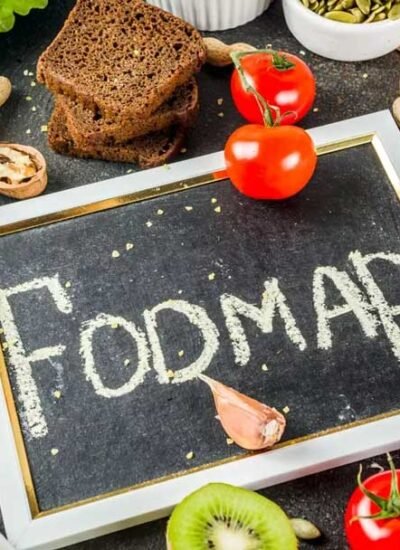If you’ve ever experienced chronic bloating, stomach pain, gas, or unpredictable bathroom habits after meals, you’re not alone—and your digestive distress could be linked to something called FODMAPs. For many people, sensitivities to these fermentable carbohydrates can wreak havoc on daily life, making mealtimes a source of anxiety rather than enjoyment.
The good news? Understanding FODMAPs—and learning how to manage your body’s reaction to them—can help you take back control of your health, your comfort, and your energy. So what is FODMAP intolerance?
What Are FODMAPs?
FODMAP is an acronym that stands for:
- Fermentable
- Oligosaccharides (e.g., fructans and galacto-oligosaccharides)
- Disaccharides (e.g., lactose)
- Monosaccharides (e.g., excess fructose)
- And
- Polyols (e.g., sorbitol and mannitol)
These are short-chain carbohydrates that are poorly absorbed in the small intestine. When they aren’t absorbed properly, they ferment in the gut, causing a range of uncomfortable symptoms. While FODMAPs are found in many otherwise healthy foods, some people’s digestive systems can’t tolerate them well—especially those with Irritable Bowel Syndrome (IBS) or other gut imbalances.
What Are the Symptoms of FODMAP Sensitivities?
FODMAP sensitivities often show up as a collection of gastrointestinal symptoms that flare up after eating. While the severity and type of symptoms vary from person to person, common ones include:
- Bloating and distension
- Gas and flatulence
- Stomach cramps or abdominal pain
- Constipation or diarrhea (or a combination of both)
- Nausea
- Feeling of fullness or heaviness after eating
For many, these symptoms don’t just cause physical discomfort—they can impact confidence, disrupt daily routines, and even lead to mental fatigue or emotional stress. When left unaddressed, FODMAP sensitivities can make it difficult to enjoy meals, socialize, or travel without worry.
Foods to Avoid on a Low FODMAP Diet
The low FODMAP diet is often used as a tool to help identify which specific types of carbohydrates are triggering symptoms. It’s usually done in three phases: elimination, reintroduction, and maintenance.
During the elimination phase, high-FODMAP foods are temporarily removed to allow the gut to settle. Some common high-FODMAP foods include:
Oligosaccharides (Fructans and GOS):
- Garlic
- Onions
- Leeks
- Asparagus
- Wheat, rye, barley (especially in large amounts)
Disaccharides (Lactose):
- Milk
- Ice cream
- Soft cheeses (like ricotta, cream cheese)
- Yogurt (unless lactose-free)
Monosaccharides (Excess Fructose):
- Apples
- Pears
- Honey
- Mango
- High-fructose corn syrup
Polyols (Sorbitol and Mannitol):
- Sugar-free gum and candies
- Stone fruits like cherries, plums, peaches, and nectarines
- Cauliflower
- Mushrooms
The goal is not to avoid these foods forever, but to reduce inflammation and identify your personal triggers. After symptoms subside, foods are slowly reintroduced, one group at a time, to see which ones your body can tolerate and in what amounts.
Treatment Options: Beyond Just Elimination
While the low FODMAP diet is incredibly effective for many, it’s not always realistic to completely avoid high-FODMAP foods in the long term. That’s where additional strategies can make a difference.
1. Digestive Enzyme Supplements
Enzyme supplements can offer relief by helping the body break down difficult-to-digest carbohydrates. These are particularly helpful when eating out, traveling, or during special occasions when food control is limited.
Some enzymes to look for:
- Lactase – helps digest lactose in dairy
- Alpha-galactosidase – helps with legumes and some vegetables
- Xylose isomerase – supports the digestion of excess fructose
- Inulinase – may assist in breaking down fructans from foods like onions and garlic
Enzymes aren’t a cure, but they’re a valuable tool in managing symptoms and reducing the stress of accidental FODMAP exposure.
2. Probiotics and Gut Healing Support
For some, food sensitivities stem from a deeper gut imbalance like SIBO (Small Intestinal Bacterial Overgrowth) or leaky gut. Targeted probiotics can help improve gut flora, while supplements like L-glutamine, zinc, and collagen can support gut lining repair.
Not all probiotics are beneficial for FODMAP sensitivities, so it’s best to work with a provider to choose the right strain and dosage.
3. Stress Management and Lifestyle Adjustments
The brain and the gut are closely connected, and stress can worsen digestive symptoms. Practicing mindfulness, getting regular sleep, exercising gently, and creating meal routines can go a long way toward calming both your mind and your gut.
If your symptoms are stress-related, cognitive-behavioral therapy (CBT) or gut-directed hypnotherapy has also shown promise for managing IBS symptoms.
4. Working with a Dietitian
A dietitian trained in the low FODMAP protocol can guide you through elimination and reintroduction phases safely. They’ll also help ensure your diet remains nutritionally balanced while avoiding certain foods.
Final Thoughts
FODMAP sensitivities can feel overwhelming at first, especially when the symptoms are invisible to others but very real to you. But with the right information and tools, relief is possible.
By learning which foods to avoid, exploring treatments like digestive enzymes, and focusing on gut health holistically, you can reduce symptoms, increase energy, and finally feel at ease in your own body again.
Food should fuel your life—not hold it back. And when your digestion works with you instead of against you, everything from mealtimes to social outings to travel becomes easier, more enjoyable, and a whole lot more comfortable.






Leave a Reply